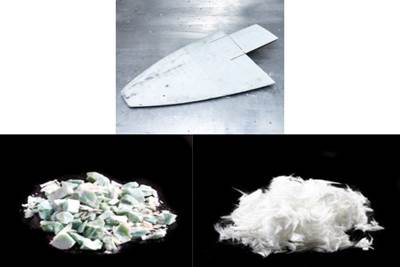GE announces U.S. blade recycling contract with Veolia
Decommissioned composite wind turbine blades will be recycled into cement production to replace raw material needs, while still enabling a net-positive environmental impact.

A wind turbine blade being prepared for removal after it has reached the end of its life cycle, with a nearby wind turbine in the backdrop. Blades like these are now being repurposed by Veolia North America after reaching the end of their life cycle, which typically lasts about 20 years. Photo Credit: Veolia, Business Wire.
GE Renewable Energy (Paris, France) announced on Dec. 8 that it has signed a multi-year agreement with Veolia North America (VNA, Boston, Mass., U.S.), a group that designs and provides water, waste and energy management solutions, to recycle wind blades removed from GE’s U.S.-based onshore turbines during upgrades and repowering efforts. Through this agreement, GE plans to recycle the majority of blades that are replaced during repowering efforts.
As a part of the agreement, blades that have been removed from turbines will be shredded at VNA’s processing facility in Missouri via the company’s cement kiln co-processing technology and then used as a raw material replacement for coal, sand and clay at cement manufacturing facilities across the U.S. On average, nearly 90% of the blade material, by weight, will be reused as a repurposed engineered material for cement production. More than 65% of the blade weight replaces raw materials that would otherwise be added to the kiln to create the cement, and about 28% of the blade weight provides energy for the chemical reaction that takes place in the kiln. Similar recycling processes in Europe have been proven to be effective at a commercial scale.
Compared to traditional cement manufacturing, blade recycling enables a 27% net reduction in CO2 emissions from cement production.
“Sustainable disposal of composites such as wind turbine blades has been a challenge, not only for the wind turbine industry, but also for aerospace, maritime, automotive and construction industries,” says Anne McEntee, CEO of GE Renewable Energy’s Digital Services business. “VNA’s unique offering provides the opportunity to scale up and deploy quickly in North America, with minimum disruption to customers and significant benefit to the environment. We look forward to working with them on this effort to create a circular economy for composite materials.”
Wind turbine blades may be replaced through turbine improvement or ‘repowering’ efforts, when specific elements of the turbine are upgraded to improve the efficiency and lifespan of the turbine, without replacing the entire machine. Longer, lighter blades help the turbine to generate more energy every year, providing even more renewable energy to their end customers.
Bob Cappadona, COO for VNA’s Environmental Solutions and Services division, says, “By adding wind turbine blades — which are primarily made of fiberglass — to replace raw materials for cement manufacturing, we are reducing the amount of coal, sand and minerals that are needed to produce the cement, ultimately resulting in greener cement that can be used for a variety of products. Last summer, we completed a trial using a GE blade, and we were very happy with the results. This fall we have processed more than 100 blades so far, and our customers have been very pleased with the product.”
An environmental impact analysis conducted by Quantis U.S. found that the net effect of blade recycling through cement kiln co-processing is positive in all categories. Compared to traditional cement manufacturing, blade recycling enables a 27% net reduction in CO2 emissions from cement production and a 13% net reduced water consumption. In addition, a single wind turbine blade that weighs 7 U.S. tons recycled through this process enables the cement kiln to avoid consuming nearly 5 tons of coal, 2.7 tons of silica, 1.9 tons of limestone and nearly a ton of additional mineral-based raw materials. Largely due to the avoided coal consumption, this type of blade recycling also has a net-positive environmental impact in the categories of human health, ecosystem quality and resource consumption. The resulting cement has the same properties and performance as cement manufactured using traditional means, meeting all applicable ASTM standards.
According to GE, recycling decommissioned wind turbine blades into cement production will aid the cement industry in its efforts to decarbonize. Likewise, GE Renewable Energy is committed to reducing environmental impacts throughout the life cycle of its products, including by announcing an ambitious pledge in 2019 to decarbonize its operations and achieve carbon neutrality by the end of 2020.
Related Content
Novel composite technology replaces welded joints in tubular structures
The Tree Composites TC-joint replaces traditional welding in jacket foundations for offshore wind turbine generator applications, advancing the world’s quest for fast, sustainable energy deployment.
Read MoreDrag-based wind turbine design for higher energy capture
Claiming significantly higher power generation capacity than traditional blades, Xenecore aims to scale up its current monocoque, fan-shaped wind blades, made via compression molded carbon fiber/epoxy with I-beam ribs and microsphere structural foam.
Read MoreMingYang reveals 18-MW offshore wind turbine model with 140-meter-long blades
The Chinese wind turbine manufacturer surpasses its 16-MW platform, optimizes wind farm construction costs for 1-GW wind farms.
Read MoreECOHYDRO project to enable recyclable composites for hydrogen storage
With the involvement of two schools from the Institut Mines-Télécom, the 4-year project aims to improve the intrinsic properties of a composite material based on Elium via four concrete demonstrators.
Read MoreRead Next
UT receives funding for wind turbine blades recycling technology
The university is developing a large-scale glass fiber composite recycling system as an end-of-life (EoL) solution for wind blades.
Read MoreDeveloping bonded composite repair for ships, offshore units
Bureau Veritas and industry partners issue guidelines and pave the way for certification via StrengthBond Offshore project.
Read More“Structured air” TPS safeguards composite structures
Powered by an 85% air/15% pure polyimide aerogel, Blueshift’s novel material system protects structures during transient thermal events from -200°C to beyond 2400°C for rockets, battery boxes and more.
Read More


























